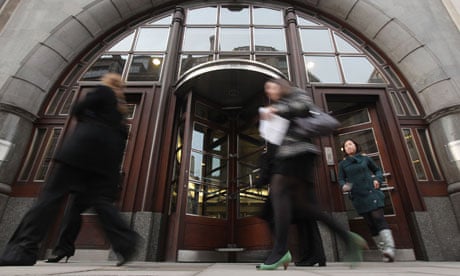Goldman Sachs has disclosed that its senior staff in London received an average pay deal of £1.8m in 2011.
Regulatory filings required under European Union rules, show (pdf) that 95 Goldman staff shared a total of £169m ($273m) for their work last year, 45% in cash and the rest in a type of shares.
The EU rules oblige banks to disclose how many code staff – those deemed to be responsible for taking and managing risks – they employ and how much have they have been paid.
The disclosures for the 2011 financial year come as the firm and its rivals across the City prepare to hand out bonuses for 2012 in the early weeks of the new year.
Bankers' bonuses have been the subject of intense scrutiny since the 2008 financial crisis, and the EU rules were introduced to try to lift the lid on the way bankers are paid. The 2011 disclosures are only the second time bankers' pay has been revealed in such detail.
The code staff's £1.8m average is considerably higher than Goldman's firm-wide average, but substantially down on the previous year when they averaged £4m. Identities of the staff are not disclosed.
In 2011 Goldman slumped to a loss in the third quarter, only the second time it had failed to report a quarterly profit since becoming a public company in 1999. The losses were caused by writedowns on the value of investments, and by the end of the financial year the firm was back in profit. At the time it said its compensation and benefits pool had slumped by 21% to $12.2bn, reducing the average for all Goldman employees to $367,057.
The regulatory filling is for Goldman Sachs Group Holdings (UK), the main London arm of the firm, and requires calculations to be made about the value of what are known as restricted stock units, which pay out in five years' time. The firm awarded 1.4m of these to code staff in 2011, at a share price of $107, valuing the total at around £92m ($155m). The code staff also received cash of £76m ($125m).
Comparisons with other banks are difficult as definitions of code staff require some interpretation. Barclays, for instance, said in 2011 that it had 238 code staff who received an average of £1.2m, while RBS had 386 code staff who received average pay of £820,000. They both had more code staff than Goldman because their head offices are in London.
Goldman will publish full-year results next month. Its most recent set of figures, for the third quarter of 2012, showed profits of £930m.
In its filing for 2011 Goldman disclosed that it used the remuneration consultants Semler Brossy, including to assess the pay of 430 partners across the firm.
"Variable remuneration is based on multiple factors and is not set as a fixed percentage of revenue or by reference of any other formula. Firmwide performance is a key factor in determining variable remuneration," the filing said.
While "forfeiture and recapture" provisions exist to claw back bonuses, they do not appear to have been used in 2011. No signing-on fees or payoffs were made.
